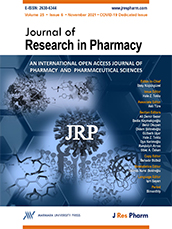Editor-in-Chief
Hatice Kübra Elçioğlu
Vice Editors
Levent Kabasakal
Esra Tatar
Online ISSN
2630-6344
Publisher
Marmara University
Frequency
Bimonthly (Six issues / year)
Abbreviation
J.Res.Pharm.
Former Name
Marmara Pharmaceutical Journal
Journal of Research in Pharmacy
2021 , Vol 25 , Issue 6
Bioflavonoids as potential target inhibitors in COVID-19: An in silico analysis
1College of Pharmacy, Koneru Lakshmaiah Education Foundation, Vaddeswaram, Andhra Pradesh, India2Department of Pharmaceutical Chemistry, Manipal College of Pharmaceutical Sciences, Manipal Academy of Higher Education, Manipal, Karnataka, India DOI : 10.29228/jrp.94 COVID-19, a respiratory pandemic associated with morbidity and mortality due to the lack of FDA approved drugs for the appropriate preventive or treatment strategies. Repurposed drugs such as antiviral and antimalarials are in clinical trials for the development of novel therapeutic agents for the treatment of SARS-CoV-2 infection. The main protease (Mpro. Molecular dynamic simulation studies (20 ns) were carried out to study protein-ligand complex stability by using Schrodinger, LLC’s Maestro Molecular Platform (version 11.8). ADMET properties, target and antiviral potentials were predicted for the top interacting bioflavonoids and significant data were reported. The parameters such as MolDock scores, ReRank scores and interaction poses were predicted for the top interacting phytocompound. In silico analysis showed that hesperetin and malvidin bind effectively at the active site of Mpro and NendoU with a MolDock score of -100.78 and -86.51 respectively. Molecular dynamic simulations have shown that the protein ligand complex was stable and exhibits good binding interactions with various amino acids. MM GBSA studies showed -52.51±5.01 and -22.80±3.04 free binding energies for hesperetin and malvidin respectively. The current research created a new perspective in understanding hesperetin and malvidin as potent Mpro and NendoU inhibitors, and further research may confirm their therapeuti c potentials in COVID 1919. Keywords : Dynamic simulation studies; SARS-CoV-2; flavonoids; in silico molecular docking; main protease

